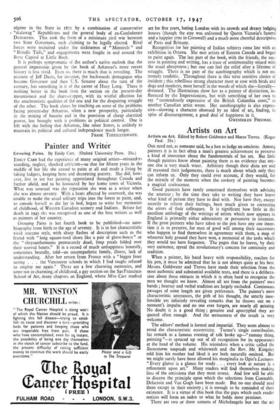Painter and Writer
Growing Pains. By Emily Carr. (Oxford University Press. 21s.)
EMILY CARR had the experience of many original artists—misunder- standing, neglect, shocked criticism—so that for fifteen years in the middle of her life she ceased to paint at all and made a living by taking lodgers, keeping hens and decorating pottery. She did, how- ever, live to see her painting appreciated throughout Canada and farther afield, and to be honoured by her home town of Victoria. What was unusual was the reputation she won as a writer when she was almost seventy. With a heart affected by overwork, she was unable to make the usual solitary trips into the forest to paint, and, to console herself as she lay in bed, began to write her memories of childhood, of Western Canadian scenery and Indians. Before her death in 1945 she was recognised as one of the best writers as well as painters of her country.
Growing Pains is her fourth book to be published—an auto- biography from birth to the age of seventy. It is in her characteristic vivid staccato style, with sharp flashes of description such as the friend with "long square-toed shoes like a pair of glove-boxes" or the "chrysanthemums prematurely dead, limp petals folded over their starved hearts." It is a record of much unhappiness honestly, sometimes brutally, told—an unsympathetic family, illness, lack of understanding. After her return from France with a "bigger freer seeing . . . the Vancouver schools in which I had taught refused to employ me again." There are a few charming memories, and some not so charming, of childhood, a gay section on the San Francisco School of Art, many chapters on England, where Miss Carr studied art for five years, hating London with its crowds and dreary lodging houses (though the stay was enlivened by Queen Victoria's funeral and a happier time in Cornwall) and a much more cheerful description of Paris and Brittany.
Recognition for her painting of Indian subjects came late with an exhibition in Ottawa. She met artists of Eastern Canada and began to paint again. The last part of the book, with the friends, the suc- cess in painting and writing, has a trace of sentimentality mixed with the usual abruptness ; but one can feel the relief after a lifetime of struggle. There is no part of the autobiography which is not ex- tremely readable. , Throughout there is this terse sensitive choice of incident ;-this rebellious strong character most at ease with birds and
dogs and monkeys, most herself in the woods of which she—literally- dreamed. The illustrations show her as a painter of distinction, in-
fluenced by the Impressionists, but with something of her own to say "tremendously expressive of the British Columbia coast," as another Canadian artist wrote. Her autobiography is also expres- sive—showing a character obsessed by an ideal of art, finding, in spite of discouragement, a good deal of happiness in it.
GWENDOLEN FREEMAN.


































 Previous page
Previous page